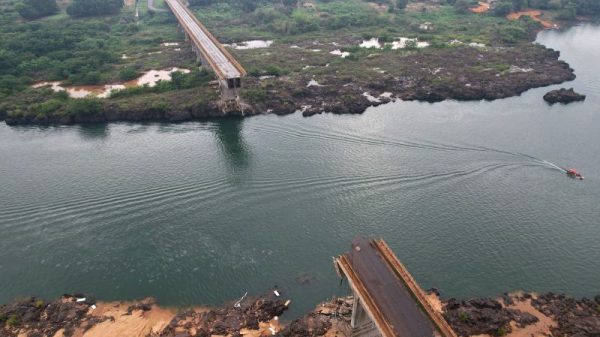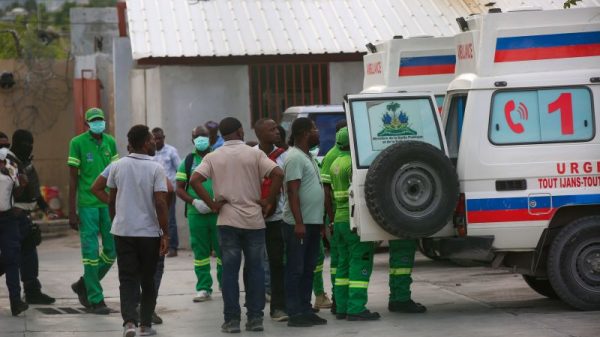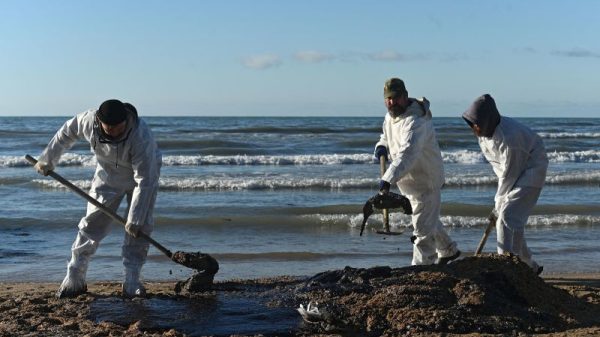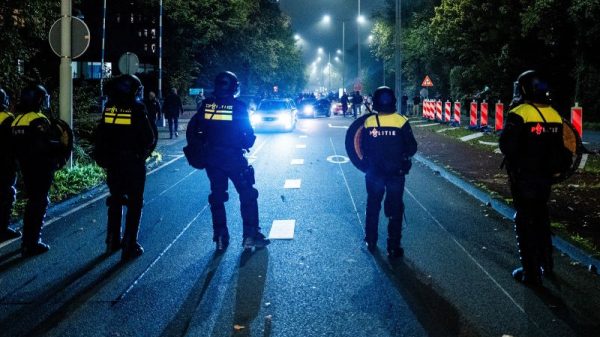One man carries six jars of cooking oil as he struggles to walk across the rubble. Two little girls run as they each carry stacks of white paper, used to build fire for heat and cooking. A group of men argue, elbowing each other as they battle to find a bag of flour, some tea or even a forgotten blanket.
These are the scenes from the central Gazan city of Deir al-Balah, where an apparent Israeli airstrike on Monday destroyed not only homes and streets, but also the neighborhood’s Al-Baraka bakery, one of the few still standing in the Strip.
The strike in Dier al-Balah occurred overnight, according to residents, and by morning men, women and children were digging through the rubble. But this time, the residents weren’t digging to find loved ones. They were desperately searching for food and other essential supplies.
As the Israel-Hamas war enters its ninth week, signs are emerging of social order breaking down, with reports of looting by people struggling to survive. Since October 9, Israel has blocked access to water, food and electricity in the Strip that is home to more than 2 million Palestinians.
More than 15,899 people have been killed in Gaza since Israel started its campaign there, according to the Hamas-controlled Ministry of Health in Gaza.
In late October, the United Nations warned that order may be breaking down as thousands of desperate Palestinians were taking basic items like flour and hygiene supplies from warehouses. “People are scared, frustrated and desperate,” Thomas White, director of affairs in Gaza for the UN Relief and Works Agency for Palestine Refugees in the Near East (UNRWA), said at the time.
“Look at the people,” he said, referring to the crowd of Palestinians digging through the rubble. “This is all from hunger.”
Gaza’s entire population is in need of food assistance, according to the World Food Programme (WFP), adding that at the start of the current crisis, the relief organization was operating with 23 bakeries.
“But food systems are collapsing. The last bakery that WFP had been working with was shut down because it had no fuel or gas,” the UN agency says on its website.
Al-Baraka bakery used to ease people’s suffering by providing much-needed bread, said Ibrahim Dabbour, another resident of Deir al-Balah. “The bakery should be outside of military operation,” he added.
A day after the IDF said it was expanding its ground operation, it said it struck about 200 Hamas targets in the Gaza Strip. Its targets included a school in the northeastern city of Beit Hanoun, which the IDF claimed contained “terror infrastructure,” including tunnel shafts stocked with weapons and explosives, a vehicle holding weapons and an arms storage facility.
The Israeli navy also struck a number of targets overnight, “assisting with the reinforcement of ground troops,” the IDF said.
The strikes come in the wake of the resumption of Israel’s military campaign against Hamas after the collapse of a truce between both sides. Israel has made it clear that its next phase will include the entire territory, including parts of southern Gaza, where thousands of displaced Palestinians fleeing the fighting in the north have been sheltering.
While the United States has warned Israel to minimize civilian casualties in the south, Israel is bent on destroying Hamas after the militant group’s October 7 assault, in which the militant group killed approximately 1,200 in Israel and kidnapped around 240 others.
Leaflets and evacuation phone calls
While Gazans often heed Israel’s calls to evacuate, many say that wherever they go, they are haunted by the prospect of death – whether it is by airstrike or starvation.
The Israeli military has repeatedly dropped leaflets over the southern city of Khan Younis in recent days, calling the area a “fighting zone” and telling residents to “evacuate immediately.”
On Sunday, the IDF again told people to evacuate several areas southeast of Khan Younis, instructing citizens to move further south. Southern Gaza had been designated a safe area when Israel was conducting its operation in the north, prompting more than 1 million people to move there from the north.
The instructions were repeated on social media, where the Israeli military Friday published a new map of Gaza, dividing the Strip into hundreds of numbered sectors which it called “evacuation zones.”
Critics have said the map is confusing and inaccurate.
“The Israeli army is again telling people in Khan Younis to flee,” Sari Bashi, program director at Human Rights Watch, said on X, formerly Twitter, commenting on an IDF image of one of the maps, which divides neighborhoods into blocks. “Again, the map contradicts the written instructions (What’s up with blocks 55? 38-46?).
“They know there’s no safe place to go and no safe way to get there,” Bashi added.
But few Palestinians have been able to make use of Israel’s map. Some have not seen the leaflets, while those who have say they have neither power nor internet access to scan the barcode, as Israel has cut off both.
Israel said it would use the map to advise people on where to evacuate.
The leaflets Israel has dropped include a QR code, which when scanned with a smart phone shows a map of the Gaza Strip, marked like a grid showing what Israel says are safe and unsafe zones for civilians.
Many other Gazans, living in poverty, are not in possession of smart phones.
“There is no electricity, there is no internet,” said Khalil Abu Marahil, adding that since his evacuation from Gaza City, he and many others have relied on leaflets, radios in hospitals or word of mouth for news.
Around 1.9 million people, more than 80% of Gaza’s total population, have been internally displaced across the Gaza Strip since October 7, according to UNRWA, which estimates that nearly 1 million people are sheltering in facilities in central and south Gaza, including Khan Younis and Rafah.
“We’ve had no internet for the 50 days now,” Sally Essam, a displaced Palestinian currently residing in Deir al-Balah, said. “Only God knows where next after Deir al-Balah.”







































